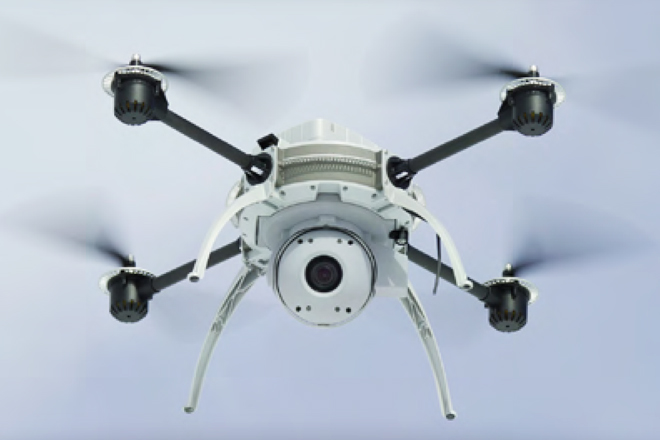by Jason Foscolo
Ariel Schwartz at fastcoexist.com postulates the fascinating idea that aerial drones can be used to circumvent so-called “ag gag” laws that restrict the use of photography and video to expose the abuse of livestock. The idea is so original it deserves detailed consideration. The article’s subtitle posits: “Some states have made it illegal for people to take photos or video of livestock operations. Drones to the rescue?”
Upon examining a few state ag gag laws, it appears that drones may be a viable way for activists to circumvent the laws, but not because the drones do not qualify as “people.” Drones instead make it possible to exploit ambiguities in trespass law.
 Some states’ ag gag laws simply would not apply to the drone hypothetical. For example, Iowa’s law (Iowa Code § 717A.3A) states that “a person is guilty of agricultural production facility fraud” if the person obtains access to an agricultural operation by false pretenses, or makes a false statement on a job application in order to perform an act within the facility “not authorized by the owner.” Basically, this statute makes it illegal to lie on a resume in order to surreptitiously film inside of an ag business.
Some states’ ag gag laws simply would not apply to the drone hypothetical. For example, Iowa’s law (Iowa Code § 717A.3A) states that “a person is guilty of agricultural production facility fraud” if the person obtains access to an agricultural operation by false pretenses, or makes a false statement on a job application in order to perform an act within the facility “not authorized by the owner.” Basically, this statute makes it illegal to lie on a resume in order to surreptitiously film inside of an ag business.
Similar to the Iowa law, Utah (Utah Code Annotated § 76-6-112) criminalizes entry by a person into an agricultural operation under false pretenses for the purpose of taking pictures as well. The Utah law, however, goes a bit further by also criminalizing the taking of pictures and video during a criminal trespass. Interestingly enough, “entry” is defined as “intrusion of the entire body” onto someone else’s land (Utah Code Annotated § 76-6-206). This “body” requirement makes this the one specific ag gag statute we found so far which could be circumvented by a flying Go Pro.
Kansas (K.S.A.§ 47 – 1827) prohibits a person from entering into an animal facility, not then open to the public, or remaining concealed after invitation, with intent to “take pictures by photograph, video camera or by any other means.” In essence, this is just a specialized form of trespass.
Idaho’s law (Section § 18-7042 of the Idaho Code) is both a beefed-up trespass statute and a “don’t lie on your resume” statute. It criminalizes a “person” who “is not employed by an agricultural production facility and enters an agricultural production facility by force, threat, misrepresentation or trespass,” obtains “employment with an agricultural production facility by force, threat, or misrepresentation with the intent to cause economic or other injury to the facility’s operations” or who enters “into an agricultural production facility that is not open to the public and, without the facility owner’s express consent or pursuant to judicial process or statutory authorization, makes audio or video recordings of the conduct of an agricultural production facility’s operations.”
Montana criminalizes the unauthorized acquisition or exercise of control over a production facility. The act also prohibits entry into an animal facility to take pictures by photograph, video camera, or other means with the intent to commit criminal defamation (Montana Code Annotated § 81-30-103). Montana makes the most deliberate effort to broaden the definition of “person” to include “a state agency, corporation, association, nonprofit corporation, joint-stock company, firm, trust, partnership; two or more persons having a joint or common interest; or some other legal entity” (Montana Code Annotated § 81-30-102).
For those ag gag laws predicated on entry into an agricultural facility, a hypothetical drone case is not likely to turn on the personhood of the drone. There may be some elasticity in the definition of personhood that is not contemplated by the statute but nevertheless would allow a criminal prosecution. Any ag gag prosecutor could argue that a person mediates their presence through the drone, which is under his or her control. The flying machine would be considered an extension of the operator for the purposes of establishing presence. Typically, a person can be liable for a trespass if he or she causes a thing to enter onto someone else’s property.
These cases are more likely to turn on the issue of whether a trespass or entry has occurred. A drone does not “enter” a facility in the way that all of these ag gag statutes contemplate, and whether or not a trespass can be committed by a remote controlled flying camera is ambiguous. The Volokh Conspiracy had a great post about drones and trespass from a few years back, which explains that land owners have the right to “exclusive control of the immediate reaches of the enveloping atmosphere,” which includes “at least as much of the space above the ground as he can occupy or use in connection with the land.” Given the novelty of drone technology, there is yet no clear indication of how low is too low for drone flight to be considered a trespass. An ambiguity this big, especially in the realm of criminal law, is ripe for exploit by animal welfare organizations.















